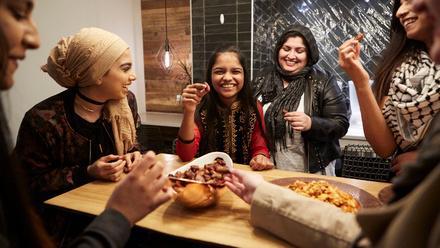Tadala Kolawole explains how her team embedded cultural training in their department and found that diversity of values is as important as diversity of ethnicity.
Ever left a training session only to find that, within 24 hours, the specifics had slipped through the cracks of your memory? You might retain the core principles related to your practice but stumble when it comes to applying them.
I’ve experienced this first-hand after numerous conferences, relying on hastily scribbled notes to jog my memory. This phenomenon, based on the works of Herman Ebbinghaus, is known as the forgetting curve, where information learned is quickly forgotten if not reinforced through practice, review, or reflection.1
In this article, we delve into the proactive approach taken by a team of renal dietitians at the Royal London Hospital to counteract the effects of the forgetting curve following cultural intelligence training.
This programme changed our perspectives and approach to what a collaborative work environment looked like when working with a diverse group of people.
Diversity
Situated in East London, Barts Health NHS Trust serves a diverse population and has an equally diverse workforce.
The organisation recognises the pivotal role of cultural intelligence and its positive impact on both staff and patient care. Cultural intelligence is the ability to function effectively in culturally diverse situations.2
A cultural intelligence (CQ) programme was rolled out as one of its strategic commitments to its equality, diversity and inclusion strategy. The aim is to embed inclusion and cultural intelligence throughout Barts Health and create an inclusive and culturally intelligent workforce.
According to the HCPC, 82% of dietitians in the UK are white and 91% are female, meaning most dietetic teams are predominantly composed of white women.3 In light of this data, our dietetics team reflects greater ethnic diversity compared to many other dietetic teams across the nation – having dietitians of varying backgrounds including Iran, Pakistan, Bangladesh, Malawi, Guyana, South Africa, Ireland and Britain and we are very proud of this, especially for a dietetics team in London. This diversity brings forth the possibility of myriad perspectives, experiences and ideas, fostering innovation and creativity. However, it can also present challenges related to effective communication, collaboration, and understanding. Cultural intelligence is the key to unlocking the potential of such diverse teams.
Cultural intelligence (CQ) training
As the Diversity and Inclusion lead for my team, I knew how beneficial this training session would be for our team to attend together, but I was worried about having all dietitians in training and not on the wards. An arrangement was made for a comprehensive bespoke session for two different groups of dietitians, split over two half-days to minimise the impact on patient care in our busy tertiary centre.
Cultural intelligence is essential for us to understand our individualised styles of working and communicating which are shaped by our distinct cultural value preferences. Cultural values significantly influence our approaches to work, particularly in the high-pressure, demanding environments many of us operate in.
In the training, we completed a value-based questionnaire which helped us identify where possible clashes could be occurring based on differences in communication styles and cultural value orientation. We delved deep into appreciating each other’s cultural norms, taboos and values, learning to embrace our team’s diversity without judgement.
How we blunted the forgetting curve
Following the training session, we (as a team) reflected on our learning. We developed a plan to incorporate the training into our policies and appraisals in order to ensure we continue the practice and pass it on to new employees who join our team in the future.
An example of a change we have made is to do with this cultural value orientation – low uncertainty avoidance vs high uncertainty avoidance. The culture in our team is generally one that is flexible and adaptable (low uncertainty avoidance), but we have acknowledged that, for some, this way of working can cause unnecessary anxiety (those with high uncertainty avoidance). We are more mindful to give explicit instructions and allow for flexibility – this allows for both groups to thrive. Team members are able to express how they prefer to work, thus improving working relationships and enabling staff to be more productive.
Three months later, we looked at our individual cultural value orientation and plotted our results from the value-based questionnaire on a graph and realised that a lot of our values were clustered, suggesting that were more similar than different as a whole.
Despite seeing ourselves as a team with very diverse ethnic backgrounds and nationalities, we discovered that we were recruiting very similar people with similar cultural values. We realised that diversity is more than what is on the surface, which caused us to challenge our recruitment process, for example, reviewing our interview marking criteria to ensure it is culturally informed and includes value-based interview questions such as “Give an example of a time when you have had to take on multiple points of view in making a decision.” This could indicate how the candidate prefers to interact, communicate, plan, and complete tasks.
We aim to be not just ethnically diverse, but diverse in cultural values. The training has made us think about changing from a “how well will the candidate fit into the team” point on the interview scoring sheet, to considering embracing the possibility that, although a person may not be an obvious fit, it may help us break the mould and find valuable talent we may be overlooking.
In conclusion, the cultural intelligence training we underwent was enlightening but we are aware that cultural intelligence is not a static skill but an ongoing journey of learning and adaptation. As a team it has not only enriched our interactions with other cultures, it has encouraged us to remain open-minded and receptive to new cultural insights and experiences.
Embracing diversity, fostering inclusivity and nurturing a culture of understanding are the cornerstones of success in today’s multicultural workplace.2
To minimise the effect of the forgetting curve, we continue to apply these newfound skills, and anticipate further growth and innovation in our clinical work, projects and the provision of better care for our patients.
Special thanks to Anya Clarke-Johnney for support in editing this piece.
References
- Ebbinghaus H. Memory: A contribution to experimental psychology. Ann Neurosci. 2013;20(4):155-156. doi:10.5214/ans.0972.7531.200408. Accessed 3 April 2022.
- Livermore D. What’s your CQ? (2020) Cultural intelligence centre. v5.1 PDF
- https://www.hcpc-uk.org/resources/data/2023/diversity-data-dietitians-2023/





